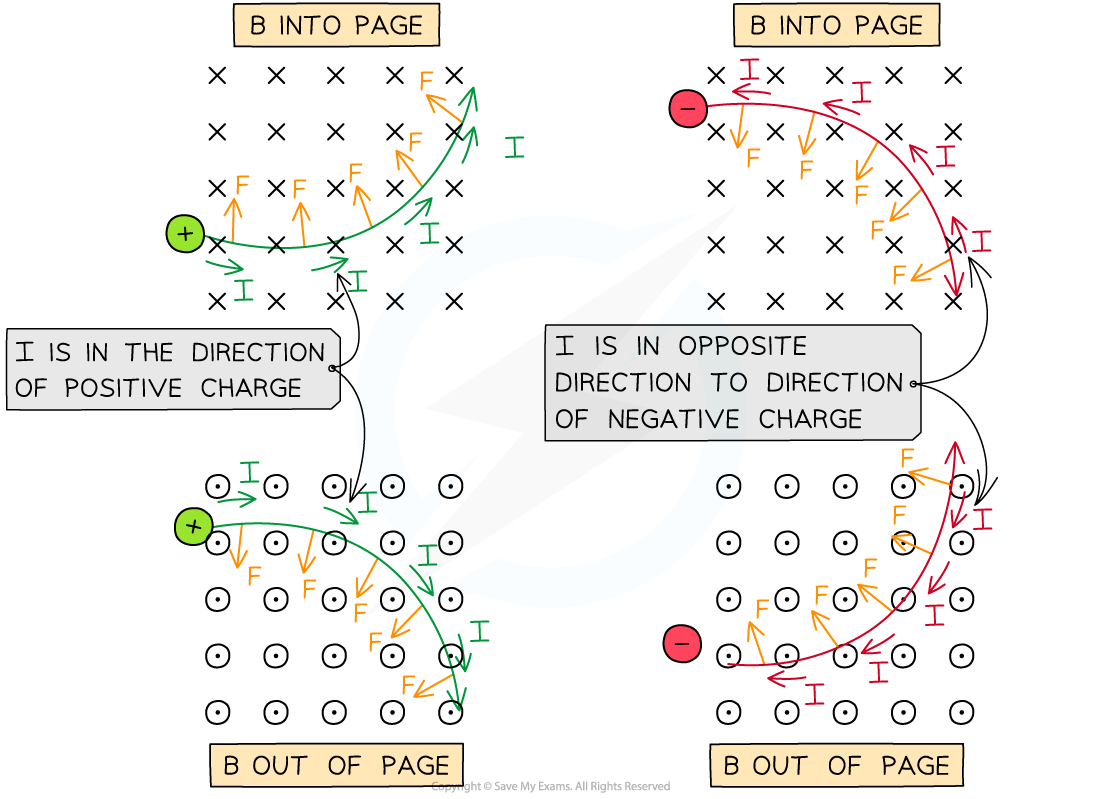Force on a Moving Charge (Cambridge (CIE) A Level Physics) : Revision Note
Calculating magnetic force on a moving charge
A moving charge produces its own magnetic field
When interacting with an applied magnetic field, it will experience a force
The force F on an isolated particle with charge Q moving with speed v at an angle θ to a magnetic field with flux density B is defined by the equation
Where:
F = magnetic force on the particle (N)
B = magnetic flux density (T)
Q = charge of the particle (C)
v = speed of the particle (m s−1)
θ = angle between charge’s velocity and magnetic field (degrees)
Current is taken as the rate of flow of positive charge (i.e. conventional current)
This means that the direction of the current for a flow of negative charge (e.g. a beam of electrons) is in the opposite direction to its motion
As with a current-carrying conductor, the maximum force on a charged particle occurs when it travels perpendicular to the field
This is when θ = 90°, so sin θ = 1
The equation for the magnetic force becomes:
F, B and v are mutually perpendicular, therefore:
if the direction of the particle's motion changes, the magnitude of the force will also change
if the particle travels parallel to a magnetic field, it will experience no magnetic force
Path of a moving charged particle in a magnetic field

The force on an isolated moving charge is perpendicular to its motion and the magnetic field B
From the diagram above, when a beam of electrons enters a magnetic field which is directed into the page:
electrons are negatively charged, so current I is directed to the right (as motion v is directed to the left)
using Fleming’s left-hand rule, the force on an electron will be directed upwards
Direction of force on a moving charge
The direction of the magnetic force on a charged particle depends on
the direction of flow of the current
the direction of the magnetic field
This can be found using Fleming's left-hand rule
The second finger represents the current flow or the flow of positive charge
For a positive charge, the current points in the same direction as its velocity
For a negative charge, the current points in the opposite direction to its velocity

Fleming’s left-hand rule allows us to determine the direction of the force on a charged particle
From the diagram above, when a positive charge enters a magnetic field from left to right, using Fleming's left-hand rule:
the first finger (field) points into the page
the second finger (current) points to the right
the thumb (force) points upwards
When a charged particle moves in a uniform magnetic field, the force acts perpendicular to the field and the particle's velocity
As a result, it follows a circular path

The direction of the magnetic force F on positive and negative particles in a B field in and out of the page
Worked Example
An electron moves in a uniform magnetic field of flux density 0.2 T at a velocity of 5.3 × 107 m s−1.
Calculate the force on the electron when it moves perpendicular to the field.
Answer:
Step 1: Write out the known quantities
Velocity of the electron, v = 5.3 × 107 m s−1
Charge of an electron, Q = 1.60 × 10−19 C
Magnetic flux density, B = 0.2 T
Step 2: Write down the equation for the magnetic force on an isolated particle
The electron moves perpendicular (θ = 90°) to the field, so sin θ = 1
Step 3: Substitute in values, and calculate the force on the electron
F = (0.2) × (1.60 × 10−19) × (5.3 × 107) = 1.7 × 10−12 N (2 s.f.)
Examiner Tips and Tricks
Remember not to mix this up with F = BIL!
F = BIL is for a current carrying conductor
F = BQv is for an isolated moving charge (which may be inside a conductor)
Remember not to get this mixed up with Fleming's right-hand rule. That is used for a generator (or dynamo), where a current is induced in the conductor. Fleming's left-hand rule is sometimes referred to as the 'Fleming's left-hand rule for motors'.

You've read 0 of your 5 free revision notes this week
Sign up now. It’s free!
Did this page help you?
